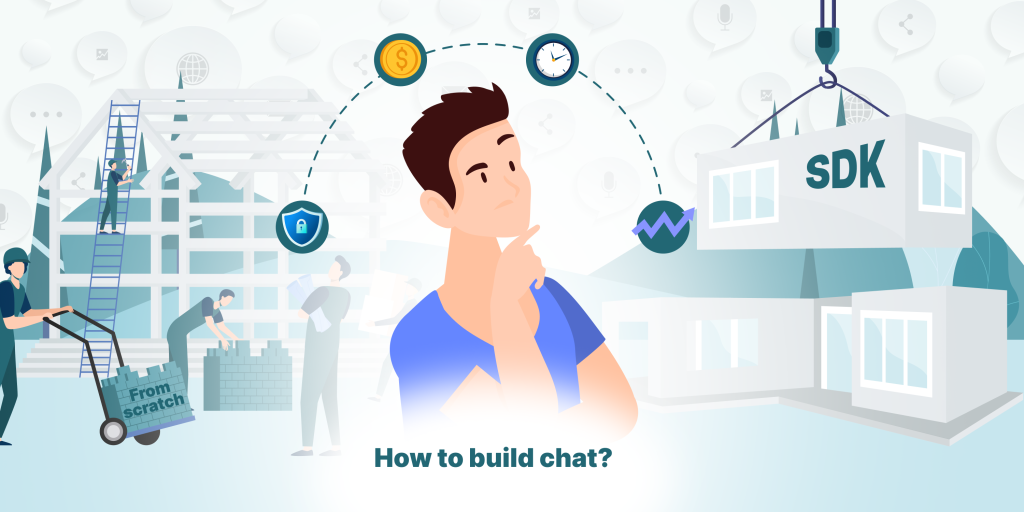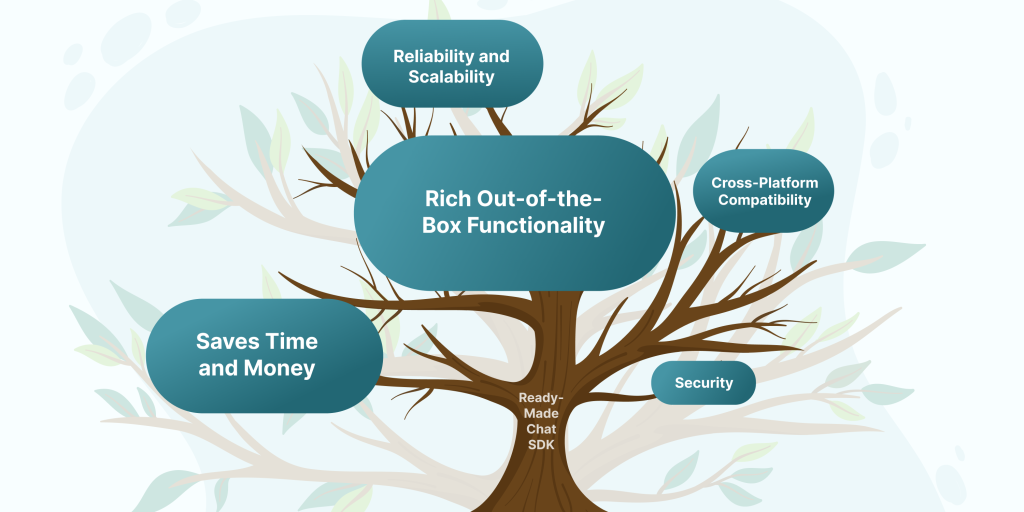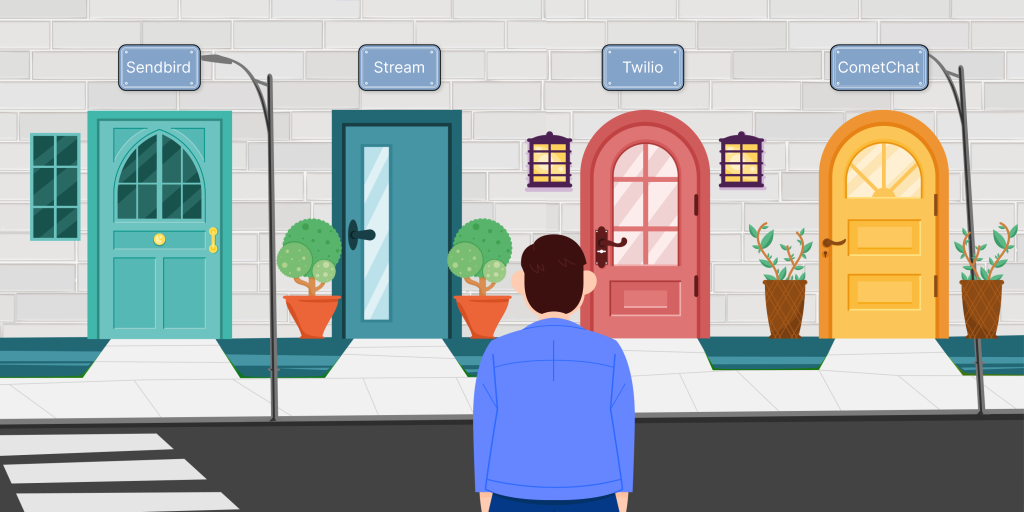
In today’s mobile app landscape, real-time communication has evolved from a nice-to-have feature into a key element for user engagement and retention. Whether it’s for customer support, a social platform, or an online marketplace, a high-quality chat can dramatically improve the user experience. Every development team at VRG Soft faces a critical decision: build a chat from scratch or use a ready-made solution?
Developing your own chat is a complex, expensive, and time-consuming process that requires deep expertise in backend infrastructure, real-time databases, and security. Ready-made SDKs (Software Development Kits) and APIs can significantly reduce time and costs by providing a reliable and scalable infrastructure.
In this article, we will compare the leading frameworks for integrating chat into Android and iOS mobile applications, examining their pros, cons, and specific features to help you make the right choice for your project.
Why Use a Ready-Made Chat SDK?

Before we dive into the comparison, let’s briefly outline the key advantages of using pre-built solutions:
- Saves Time and Money: The most obvious benefit. You avoid the need to write complex code from scratch, which reduces development costs and accelerates your product’s time-to-market.
- Reliability and Scalability: Leading providers have already solved the challenges of scaling. Their infrastructure is built to handle millions of concurrent connections.
- Rich Out-of-the-Box Functionality: Group chats, typing indicators, message statuses (delivered/read), push notifications, file sharing, and moderation tools are all available immediately.
- Cross-Platform Compatibility: All major SDKs support native development for Android (Kotlin/Java) and iOS (Swift/Objective-C), as well as popular cross-platform frameworks.
- Security: Ready-made solutions often include built-in security mechanisms, such as data encryption, saving you a major headache.
Top 4 Chat Integration Frameworks: A Comparative Analysis

We’ve analyzed the market and identified four key players: Sendbird, Stream, Twilio, and CometChat. Let’s take a closer look at each one.
1. Sendbird
Overview: Sendbird is a market leader known for its high performance and extensive feature set. The platform is geared towards large enterprises and applications with high user loads.
Key Features:
- Group chats supporting tens of thousands of users.
- Advanced moderation tools (both automatic and manual).
- Real-time message translation.
- Voice and video calls.
- Pre-built UI components (UI Kit) for fast integration.
Integration and Development:
- Android & iOS: Sendbird provides detailed documentation and native SDKs for both platforms. The integration process is well-documented. For example, on Android, it involves adding the dependency to build.gradle, initializing the SDK with your APP_ID, and connecting a user. The steps for iOS are similar and are handled via Swift Package Manager or CocoaPods.
- UI Customization: Sendbird’s UI Kit significantly speeds up development but may not be flexible enough for a truly unique design. Full customization requires more effort and working directly with the Core SDK.
Pros:
Highly reliable and scalable.
Extensive feature set, including AI-powered tools.
High-quality documentation and support.
Cons:
High cost, especially for startups.
The pricing model based on MAU (Monthly Active Users) can be unpredictable.
The UI Kit can be limiting for customization.
Pricing: A free developer plan is available (up to 1,000 MAU). Paid plans start at $349/month for 5,000 MAU.
2. Stream
Overview: Stream positions itself as a solution for building highly customizable chat experiences quickly. Its main strength lies in its powerful and flexible UI components, which allow you to easily adapt the chat’s appearance to your app’s design.
Key Features:
- Message reactions, threads, and @mentions.
- A powerful permissions system.
- AI-powered moderation.
- Very flexible and polished UI components.
Integration and Development:
- Android & iOS: Stream offers some of the best native UI components on the market. For Android, they actively use Jetpack Compose, which makes development modern and declarative. For iOS, there is full support for SwiftUI. This allows developers to build a beautiful interface quickly.
- UI Customization: The highest level of customization. You can change almost everything, from colors and fonts to the behavior of individual components, which is their key advantage.
Pros:
Best-in-class UI components and customization flexibility.
Excellent documentation with numerous examples.
A great feature set for user engagement.
Cons:
Can be more expensive than competitors at high user volumes.
Some developers find the core SDK logic to be overly complex.
Pricing: The startup plan begins at $499/month, which includes 10,000 MAU.
3. Twilio
Overview: Twilio is a giant in the world of communication APIs. Their chat product, Twilio Conversations, is part of a massive ecosystem that includes SMS, voice, and video calls. It’s the ideal choice if you need an omnichannel communication platform.
Key Features:
- Seamless integration with SMS and WhatsApp.
- Support for multi-channel conversations (a user can start a dialogue in the app and continue it via SMS).
- High reliability and global coverage.
Integration and Development:
- Android & iOS: Twilio provides native SDKs, but unlike Sendbird and Stream, they do not offer pre-built UI components out of the box. This means you will have to build the entire chat user interface from scratch.
- UI Customization: Complete freedom, as you are building the UI yourself. This is a plus for those who want a unique design but a minus in terms of development speed.
Pros:
Part of the huge and reliable Twilio ecosystem.
Excellent capabilities for creating omnichannel communication experiences.
Flexible “pay-as-you-go” pricing model.
Cons:
The lack of a pre-built UI Kit significantly slows down development.
Setup can be more complex than with competitors.
Pricing can be confusing (charges per active user per month + per message).
Pricing: Twilio offers two models: $1/active user per hour or $150/user per month. There are also fees per message (e.g., $0.0042 per WhatsApp message).
4. CometChat
Overview: CometChat is a balanced solution that offers a good set of features at a more affordable price compared to market leaders, making it an attractive option for startups and medium-sized businesses.
Key Features:
- Text chat, voice, and video calls.
- Pre-built UI components and a UI Kit.
- Extensions (Stickers, Emojis, Polls).
- AI features like smart replies and moderation.
Integration and Development:
- Android & iOS: CometChat provides native SDKs and detailed documentation. Their UI Kit allows you to launch a chat quickly, but like Sendbird’s, it may be less flexible than Stream’s.
- UI Customization: Offers a good level of customization through UI builders and pre-built components, striking a balance between speed and flexibility.
Pros:
Competitive pricing.
A wide range of features, including AI and extensions.
Simple integration thanks to ready-made UI components.
Cons:
Less well-known than giants like Twilio and Sendbird.
Some developers note that the documentation could be more detailed.
Pricing: A free plan is available. Paid plans start at $109/month for 1,000 MAU.
Quick Comparison Table
| Parameter | Sendbird | Stream | Twilio | CometChat |
| Target Audience | Large Enterprises | Product-focused Teams | Omnichannel Projects | Startups & SMBs |
| Pre-built UI Kit | Yes | Yes (very flexible) | No | Yes |
| Ease of Integration | Medium | High | Low (due to UI) | High |
| UI Customization | Medium | High | Full (but from scratch) | Medium |
| Starting Price | $349/mo | $499/mo | Pay-as-you-go | $109/mo |
| Key Advantage | Scalability | UI Flexibility | Ecosystem | Price/Value |
How to Make the Right Choice?

Choosing the ideal framework depends on the unique requirements of your project:
- For a quick MVP launch on a limited budget: Consider CometChat. It offers an excellent balance of price, features, and integration speed.
- If design and a unique UX are your top priorities: Stream is your best bet. Their flexible UI components will allow you to implement the boldest design ideas.
- For large-scale projects with high traffic and a need for scalability: Sendbird will be the most reliable and feature-rich solution.
- If you need more than just a chat, but a complete communication platform (SMS, WhatsApp): Twilio is unparalleled due to its powerful ecosystem, but be prepared for longer UI development time.
At VRG Soft, we have experience integrating various chat solutions and are ready to help you not only choose the optimal tool but also implement it in your application at the highest level.
Need a consultation on integrating chat into your project? Contact us, and we’ll help you create the best solution for your users!